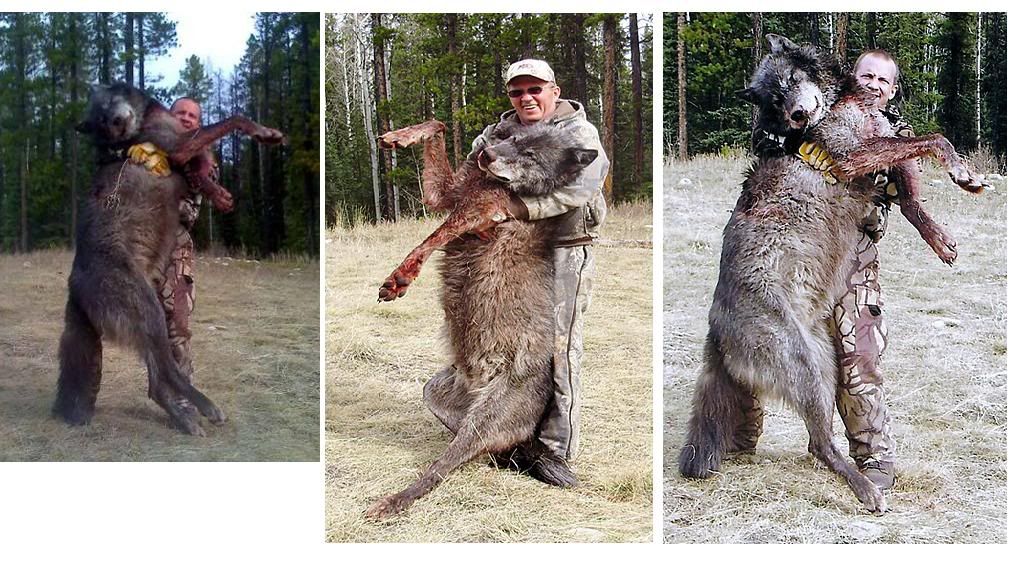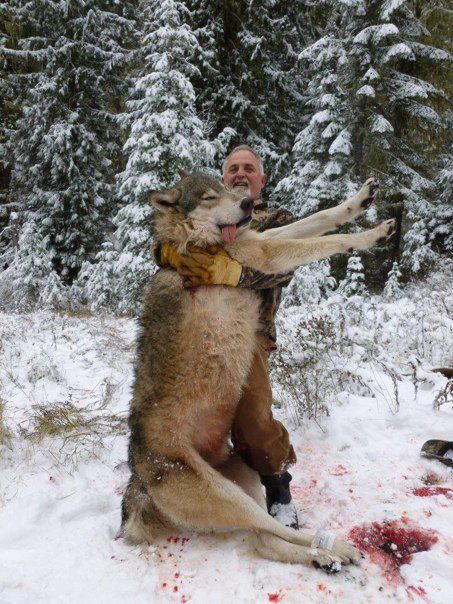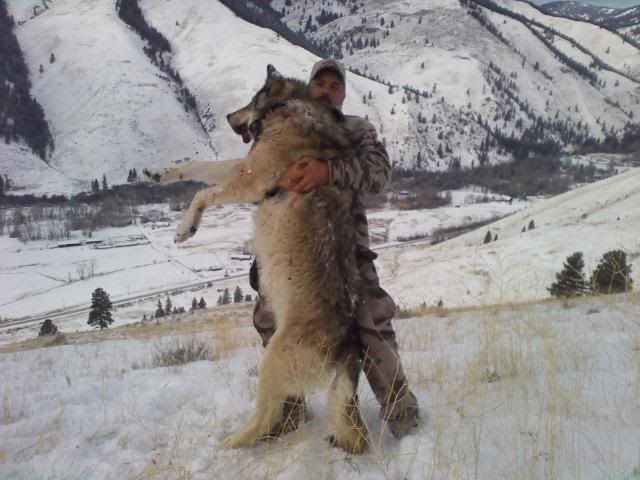If this report is truer..than what they are reporting wow..have we been given the smoke and mirrors act.
A few quotes if you don't want to read all of it.
<div class="ubbcode-block"><div class="ubbcode-header">Quote:</div><div class="ubbcode-body">“In western Wyoming upon delisting there were at
least 28 wolves in 8 packs, none of which were classified
as a breeding pair, that had all or part of their home range
in the predatory animal area. Between delisting and May 7,
2008 16 wolves have been killed in that area. Four were
killed by agency control, one was shot as it attacked
livestock</div></div>
<div class="ubbcode-block"><div class="ubbcode-header">Quote:</div><div class="ubbcode-body">“Every year, most wolf populations almost double
in the spring through the birth of pups [Mech 1970]. For
example in May 2008, there will not be 1,500 wolves, but
3,000! (Wolf population estimates are usually made in
winter when animals are at their nadir*. This approach
serves to provide conservative estimates and further insure
that management remains conservative).”</div></div>
<div class="ubbcode-block"><div class="ubbcode-header">Quote:</div><div class="ubbcode-body">“70% Kill Needed to Reduce Wolf Population”
Mech continued, “As indicated above, 28-50% of a
wolf population must be killed by humans per year (on top
of natural mortality) to even hold a wolf population
stationery. </div></div>
<div class="ubbcode-block"><div class="ubbcode-header">Quote:</div><div class="ubbcode-body">
“Wolf populations can maintain themselves despite
annual human-caused mortality rates of 30% to 50%
(Brainerd et al. 2008; Fuller et al. 2003). Wolf populations
below habitat carry-capacity can quickly expand,
sometimes nearly doubling within one or two years,
following sharp declines caused by temporarily high rates
of human-caused mortality or other causes.</div></div>
<div class="ubbcode-block"><div class="ubbcode-header">Quote:</div><div class="ubbcode-body">Wolf biologists Mech and Bangs knew then, before
any wolves were transplanted into the NRM, that hunting
and trapping, even with liberal seasons and bag limits, does
not stop continued annual increases in the wolf population.
From this and similar research in several countries,
they also realized that sport hunting and trapping creates
healthier wolf populations by removing surplus wolves that
would otherwise be killed by other wolves or die from
starvation or disease. So FWS dangled the carrot of
allowing states to “control” wolf populations by making
wolves a big game animal to get two of the three states to
accept a series of changes to the original delisting criteria </div></div>
<div class="ubbcode-block"><div class="ubbcode-header">Quote:</div><div class="ubbcode-body">An area of unique concern arose in July when
members of the Phantom Hill pack began killing sheep on
grazing allotments in the Sawtooth National Forest near
Ketchum. Even though one member of this pack had
already been radio-collared by IDFG earlier in the year,
WS was requested to radio-collar an additional animal.
(Normal protocol would have called for incremental lethal
removals to begin).
After WS radio-collared a second animal and the
pack continued to kill sheep, IDFG was still reluctant to
approve any lethal control. IDFG opted for a non-lethal
approach because of concerns about the potential reactions
from local wolf advocates if lethal control were to be
exercised. In an effort to prevent more depredations, WS
provided “less than lethal” ammunition training to the
herders in the area and provided radio activated guard boxes to the producers to help harass wolves from the
sheep. WS also spent considerable time on the ground
trying to keep the sheep and the wolves separate.
Depredations continued in spite of these nonlethal efforts.</div></div>
<div class="ubbcode-block"><div class="ubbcode-header">Quote:</div><div class="ubbcode-body">, limiting control actions to a strictly nonlethal approach in a situation like this is inconsistent with
the intent of the rules under which wolves were
reintroduced, and essentially violates a critical promise that
was made at the time of the reintroduction. The original
(1994) 10j rule clearly stated that all chronic depredating
wolves would be removed from the wild (either killed or
placed in captivity), and while the current (2005) 10j rule
appears not to contain this same explicit language, the 2005
rule was arguably meant to allow even greater latitude in
exercising lethal control when wolves attack livestock.</div></div>
<div class="ubbcode-block"><div class="ubbcode-header">Quote:</div><div class="ubbcode-body">an estimated
population of about 750 wolves in Idaho was responsible
for 422 confirmed and probable sheep and lamb deaths and
injuries, along with 84 cattle and calves, or about .67 head
of livestock attacked per wolf on the landscape.</div></div>
http://rliv.com/pic/TheOutdoorsmanMay.pdf
A few quotes if you don't want to read all of it.
<div class="ubbcode-block"><div class="ubbcode-header">Quote:</div><div class="ubbcode-body">“In western Wyoming upon delisting there were at
least 28 wolves in 8 packs, none of which were classified
as a breeding pair, that had all or part of their home range
in the predatory animal area. Between delisting and May 7,
2008 16 wolves have been killed in that area. Four were
killed by agency control, one was shot as it attacked
livestock</div></div>
<div class="ubbcode-block"><div class="ubbcode-header">Quote:</div><div class="ubbcode-body">“Every year, most wolf populations almost double
in the spring through the birth of pups [Mech 1970]. For
example in May 2008, there will not be 1,500 wolves, but
3,000! (Wolf population estimates are usually made in
winter when animals are at their nadir*. This approach
serves to provide conservative estimates and further insure
that management remains conservative).”</div></div>
<div class="ubbcode-block"><div class="ubbcode-header">Quote:</div><div class="ubbcode-body">“70% Kill Needed to Reduce Wolf Population”
Mech continued, “As indicated above, 28-50% of a
wolf population must be killed by humans per year (on top
of natural mortality) to even hold a wolf population
stationery. </div></div>
<div class="ubbcode-block"><div class="ubbcode-header">Quote:</div><div class="ubbcode-body">
“Wolf populations can maintain themselves despite
annual human-caused mortality rates of 30% to 50%
(Brainerd et al. 2008; Fuller et al. 2003). Wolf populations
below habitat carry-capacity can quickly expand,
sometimes nearly doubling within one or two years,
following sharp declines caused by temporarily high rates
of human-caused mortality or other causes.</div></div>
<div class="ubbcode-block"><div class="ubbcode-header">Quote:</div><div class="ubbcode-body">Wolf biologists Mech and Bangs knew then, before
any wolves were transplanted into the NRM, that hunting
and trapping, even with liberal seasons and bag limits, does
not stop continued annual increases in the wolf population.
From this and similar research in several countries,
they also realized that sport hunting and trapping creates
healthier wolf populations by removing surplus wolves that
would otherwise be killed by other wolves or die from
starvation or disease. So FWS dangled the carrot of
allowing states to “control” wolf populations by making
wolves a big game animal to get two of the three states to
accept a series of changes to the original delisting criteria </div></div>
<div class="ubbcode-block"><div class="ubbcode-header">Quote:</div><div class="ubbcode-body">An area of unique concern arose in July when
members of the Phantom Hill pack began killing sheep on
grazing allotments in the Sawtooth National Forest near
Ketchum. Even though one member of this pack had
already been radio-collared by IDFG earlier in the year,
WS was requested to radio-collar an additional animal.
(Normal protocol would have called for incremental lethal
removals to begin).
After WS radio-collared a second animal and the
pack continued to kill sheep, IDFG was still reluctant to
approve any lethal control. IDFG opted for a non-lethal
approach because of concerns about the potential reactions
from local wolf advocates if lethal control were to be
exercised. In an effort to prevent more depredations, WS
provided “less than lethal” ammunition training to the
herders in the area and provided radio activated guard boxes to the producers to help harass wolves from the
sheep. WS also spent considerable time on the ground
trying to keep the sheep and the wolves separate.
Depredations continued in spite of these nonlethal efforts.</div></div>
<div class="ubbcode-block"><div class="ubbcode-header">Quote:</div><div class="ubbcode-body">, limiting control actions to a strictly nonlethal approach in a situation like this is inconsistent with
the intent of the rules under which wolves were
reintroduced, and essentially violates a critical promise that
was made at the time of the reintroduction. The original
(1994) 10j rule clearly stated that all chronic depredating
wolves would be removed from the wild (either killed or
placed in captivity), and while the current (2005) 10j rule
appears not to contain this same explicit language, the 2005
rule was arguably meant to allow even greater latitude in
exercising lethal control when wolves attack livestock.</div></div>
<div class="ubbcode-block"><div class="ubbcode-header">Quote:</div><div class="ubbcode-body">an estimated
population of about 750 wolves in Idaho was responsible
for 422 confirmed and probable sheep and lamb deaths and
injuries, along with 84 cattle and calves, or about .67 head
of livestock attacked per wolf on the landscape.</div></div>
http://rliv.com/pic/TheOutdoorsmanMay.pdf





